Home>North America>Life of AB Gregory
Travels
We thought it would be beneficial to show photographs of the travels of Archbishop Gregory to various visits to holy places. Below are the photographs with captions in no special order.
The Holy Land
A Visit to Jericho in the Holy Land
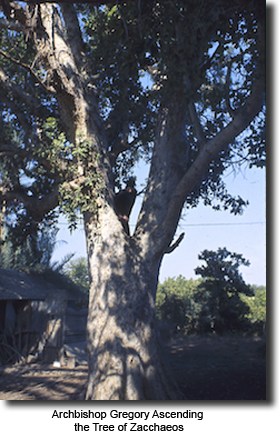
On one of Archbishop Gregory’s visits to the Holy Land when he was a simple monk, he visited the city of Jericho. It is not commonly known that the Russian Church Abroad owned the property on which the very sycamore tree that Zacchaeos climbed to see our Savior when He was passing through Jericho existed. There is also on this property a mosaic floor, the ruins of a church, that was built in Byzantine times, commemorating this event recorded in the Gospel of Saint Luke. This sycamore was not like the Oak of Mamre in Hebron, which was dying at that time in the mid 1960s. This tree in Jericho was living, and was thousands of years younger than the Oak of Mamre. Father Gregory wanted to climb up on it, just as Zacchaeos did. To accomplish this pious gesture, while no one was observing him, since all his traveling companions had entered the home of the Russian caretakers, Father Gregory had to construct a makeshift ladder. He succeeded and his traveling companions took the above picture. However, just as Zacchaeos was told to come down, so was Fr. Gregory commanded to come down immediately.
The Holy Sepulcher
On another occasion, Father Gregory and his novice monk Gabriel, the future Bishop John, made a pilgrimage to Jerusalem to witness the Holy Fire. The following photograph is the Holy Sepulcher, where the Holy Fire comes forth.
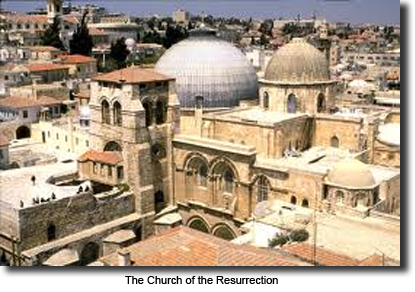
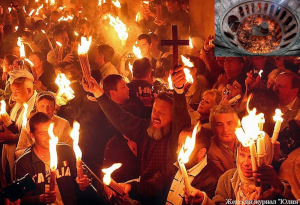
The Holy Fire
The two pilgrims witnessed this miracle on Holy Saturday, an experience they will never forget.
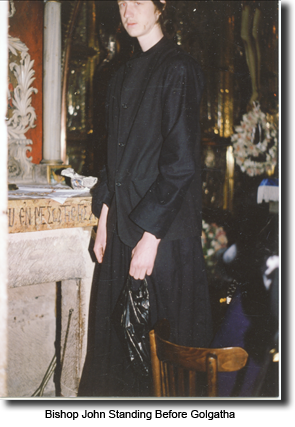
During this time Father Gregory gave the novice Gabriel his black monastic clothes in the first room of the Kavouklion, which is named after the Archangel Gabriel. The photograph above is of the novice Gabriel right after he received his black monastic habit in the church of the Holy Sepulchre, at the Proskomedi table, in the chapel dedicated to the Holy Cross.
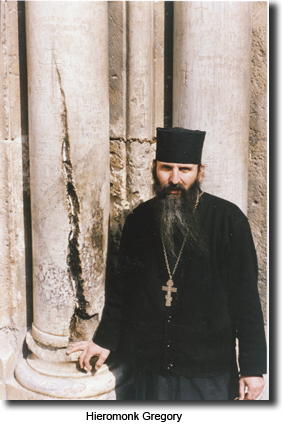
This photograph is Father Gregory outside the Church of the Holy Sepulchre where the Holy Fire came down in 1617 and cracked the column. The Orthodox were forbidden by the Moslems to enter into the church that year, so they could not receive the Holy Fire. So God sent the Holy Fire to them outside the church. It came to them from this column, and cracked it. This column will never be repaired, because it is a testimony to this great miracle. When the pious enter and leave the church of the Holy Sepulchre, they touch and kiss this holy column.
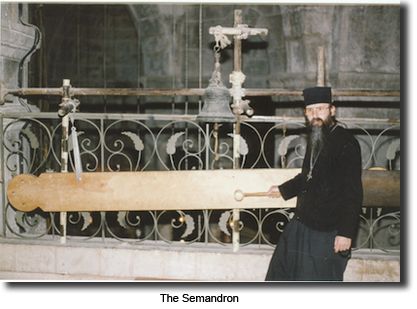
This photograph is taken in the balcony in the Church of the Holy Sepulchre, and Father Gregory is in front of the eight foot semandron, out of rock maple, that Fr. Gregory made and had shipped it to the Holy Sepulchre as a donation. In a previous trip he saw how the existing semandron had been destroyed over the years and it was decided to donate another one to this church, the Mother of all Churches in Orthodoxy. This semandron is still there, and it is hit with a certain rhythym which monastics use to call the brotherhood to prayer.
The Monastery of Saint Catherine
On a trip to the Holy Land, Father Gregory visited the monastery of Saint Catherine’s at the foot of Mount Sinai. As you can see in the photo, this is probably the only place where there is water.
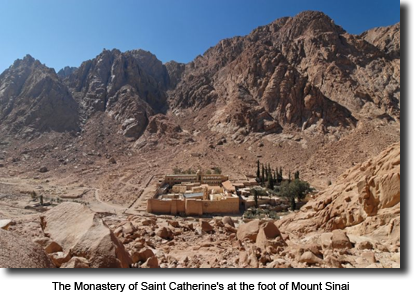
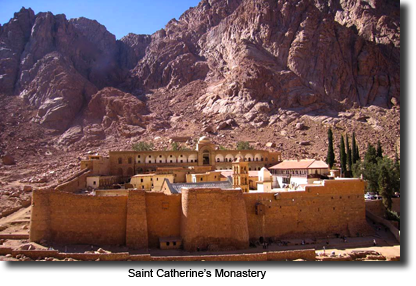
Every visitor to Mount Sinai tries to ascend the mountain. Usually this long journey starts very early in the morning and by the time you reach the top, it is midday and the weather is approaching the hottest time of the day. The descent, which is less arduous, occurs during the hottest part of the day, which makes the trip easier.
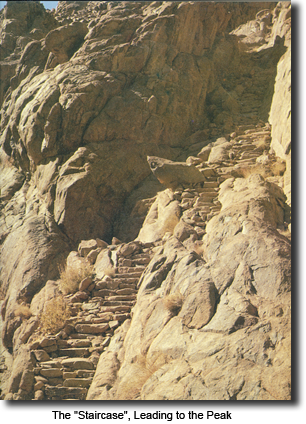
This the stairway leading to the top of the mountain, reputed to be a “short cut”! The long way is gradual, which even pack animals can travel. Can you imagine all the work it took to make steps out of the rock? Mount Sinai is 2,285 meters high, that is, 7,497 feet. There are about 3,700 steps, and the journey takes practically all morning.
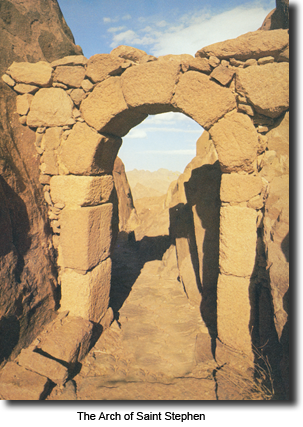
Half way up the mountain is Saint Stephen’s arch, pictured above. When the monastery of Saint Catherine’s was functioning at its height, a priestmonk, Saint Stephen, kept vigil at this arch. It was his obedience to hear the confession of all the pilgrims who intended to ascend Mount Sinai, which necessitated passing through this arch. If the pilgrims were unworthy of holy communion, they were not permitted beyond this point, and were told to return to the monastery below. Behold, how the monastics of ancient times revered this holy mountain! Only Orthodox Christians, and only those who were in good standing with the Church, could proceed beyond this point.
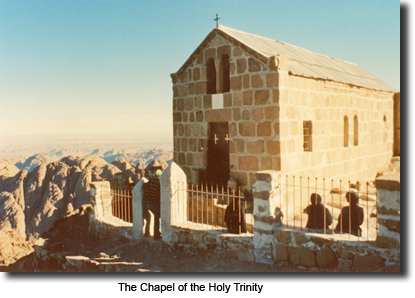
This is the peak of Mount Sinai. This is a picture of the chapel dedicated to the Holy Trinity.
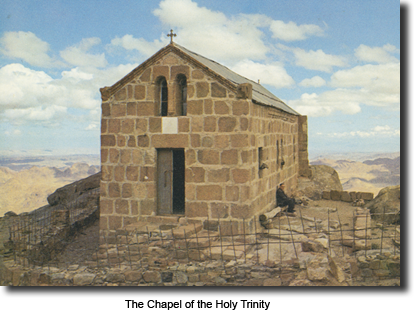
An earlier photograph of the chapel of the Holy Trinity, which was built in 1934 with the stones of the ancient chapel erected by St. Justinian in 532. On the left side of the chapel, you can see a little walkway, which goes to the back of the church. If one proceeds along this path, one comes to the cleft of the rock, in which God (Christ) placed Moses, from which point he would view the back parts of God as He passed by.
And Moses says, “Manifest thyself to me. And God said, I will pass by before thee with My glory, and I will call by My name, the Lord, before thee; and I will have mercy on whom I will have mercy, and will have pity on whom I will have pity. And God said, Thou shalt not be able to see My face; for no man shall see My face, and live. And the Lord said, Behold, there is a place by Me: thou shalt stand upon the rock; and when my glory shall pass by, then I will put thee into a hole of the rock; and I will cover thee over with My hand, until I shall have passed by. And I will remove My hand, and then shalt thou see my back parts; but My face shall not appear to thee.” (Brenton Septuagint, Exodus, 33:18-23)
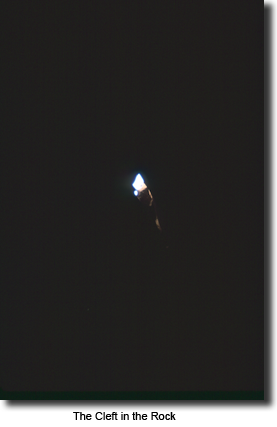
Father Gregory went into the very cleft of the rock where Moses stood, and took this picture. The other side of the mountain is clearly visible in the contrasting darkness of the narrow cave.
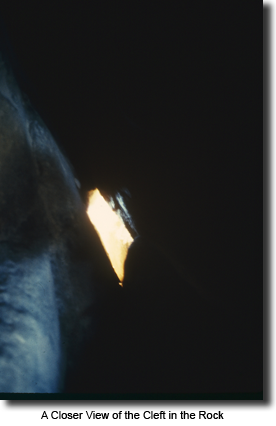
Squeezing himself in yet further, Father Gregory was able to take a closer picture of the place where God passed by Moses.
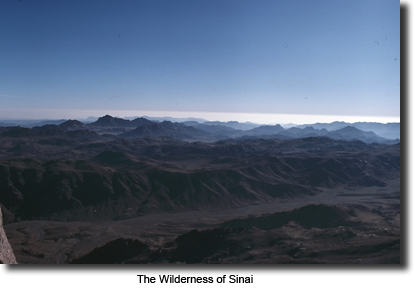
A view of the vast wilderness of the Sinai Peninsula taken by Father Gregory atop Mount Sinai, with the aperture closed to reduce the intense sunlight. Complete barrenness after barrenness. It was through this wilderness that Christ brought the children of Israel and sustained them for forty years.
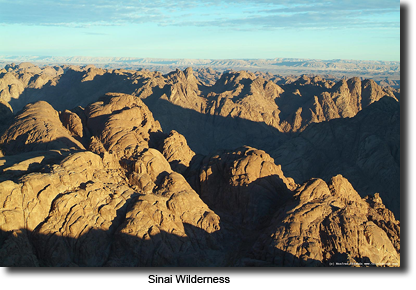
Another photo of the Sinai wilderness.
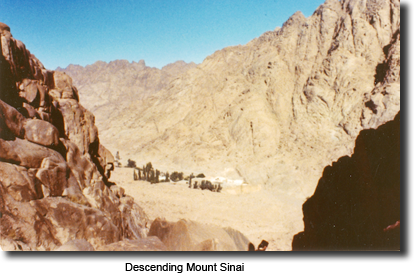
This is the view of the monastery as the party descended. Father Gregory’s head is shown in the lower part of the photo.
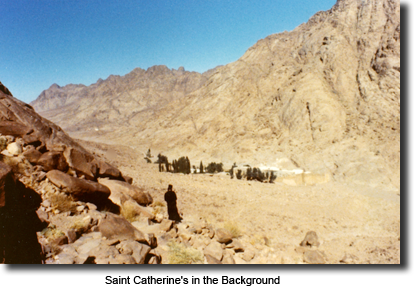
Another photograph we had of the view as we descended from the peak and drew close to the monastery. Father Gregory is shown in the center.
The Monastery of Mar Savas
On one occasion, Archbishop Gregory had the opportunity to visit the Holy Land. Among the many places he visited was the ancient Monastery of Mar Savas, where Saint Savas the Sanctified struggled in great hardships in the fifth century.
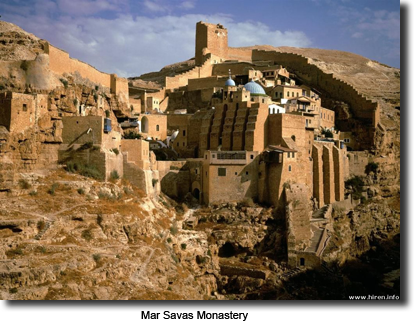
It was from this monastery that Archbishop Gregory was given relics of the martyrs of Mar Savva Monastery which he uses for the sanctification of antimensia. An antimension is a consecrated icon on cloth that has attached to it the relics of martyrs which is necessary for a priest to celebrate the holy liturgy on.
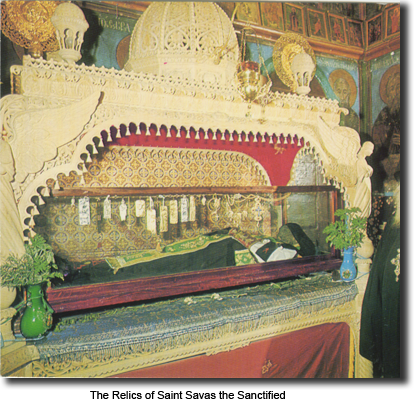
The relics of Saint Savas were stolen by the Roman Catholics in the time of the Crusades, and only recently, in the time of Ecumenism, did they decide to return them to the Monastery from which they were stolen. Saint Savas is whole and incorrupt. While in the hands of the Latins it is recorded that he worked no miracle, but as soon as he returned to Palestine, he started working miracles again after 700 years.
The Conquering of Jerusalem
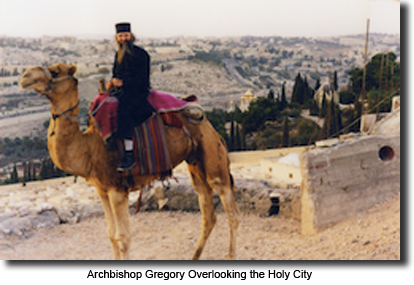
We call this picture “The Conquering of Jerusalem”
This picture was taken on top of the Mount of Olives, overlooking Gethsemane, the Brook of Kedron and Jerusalem in the background. If you look closely, you can see the golden domes of the church of Saint Mary Magdalene appearing above the cypress trees.
Greece
Relics of the Greek Isles
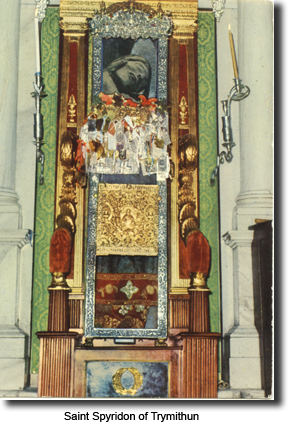
On a visit to the island of Corfu, Greece, Archbishop Gregory made a pilgrimage to offer veneration to the relics of Saint Spyridon, the holy confessor of Orthodoxy. The saint’s relics are cast in a greenish tint, because of the green colored glass that covers the relics. Apparently the manufacturers of the reliquary, or those in authority in the church, thought that tinting the glass would help preserve the relics from sunlight, neglecting the fact that God preserved the relics for 1,700 years without artificial means. Saint Spyridon was present at the First Ecumenical Council in 325, which was attended by 317 God-bearing Fathers.
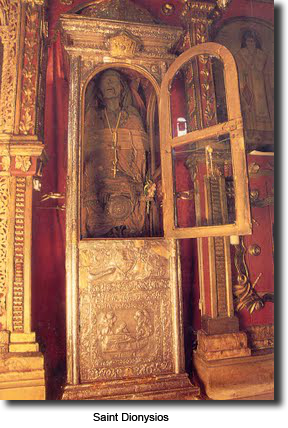
On a pilgrimage to the Island of Zakynthos, veneration was offered to the holy relics of Saint Dionysios of Zakynthos.
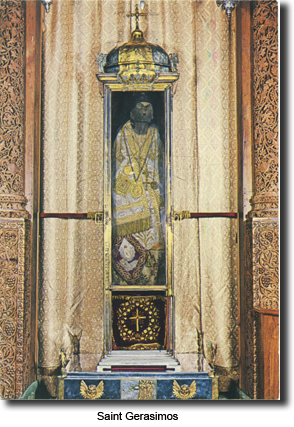
On a pilgrimage to the Island of Kephalonia, veneration was offered to the holy relics of Saint Gerasimos our righteous Father.
The above three totally incorrupt saints are on the three islands, Corfu, Zakynthos and Kephalonia, which are located in the Ioniah Sea, on the western side of Greece.
The Church of Saint Theodora of Vasta
and Her Seventeen Trees
On one occasion, Archbishop Gregory and Bishop John visited the shrine of St. Theodora of Vasta of the Peloponnesos.
Saint Theodora was martyred at the spot where this shrine is located. She prayed that her body would be a temple, her blood a river, and her hair as tall trees. The faithful built a temple over the spot of martyrdom where a spring miraculously gushed forth, which became a major source of irrigation for the whole region, and a fount of healing for the faithful. Then, miraculously, from roof of this little church sprouted seventeen trees. And the trees grew and grew until they became great and high. No one could explain how the trees could live. No one can see the roots, and all of the trees, even though they are so big, are supported by the roof of this little church dedicated to St. Theodora. Below are pictures of this church which has become a pilgrimage point for many pious people over the last century.
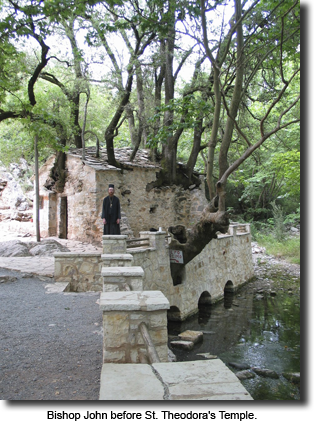
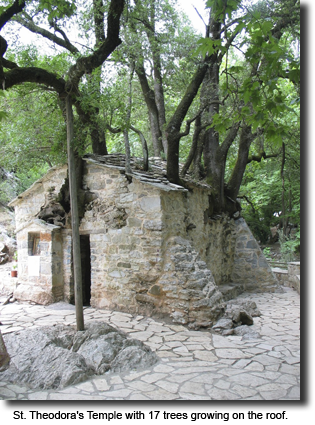
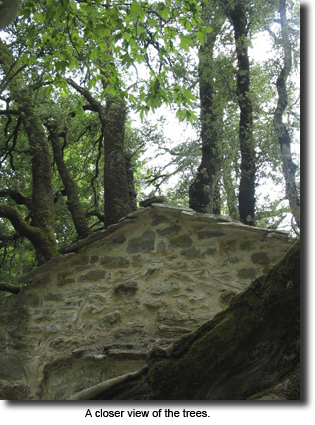
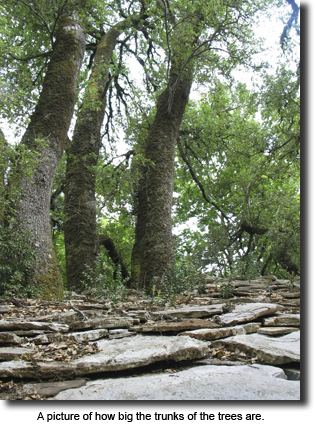
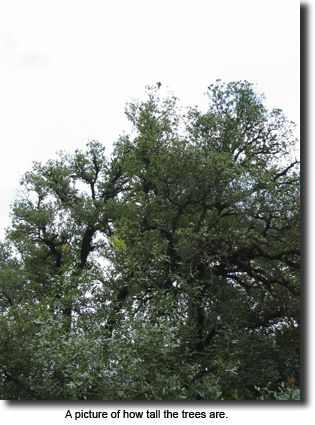
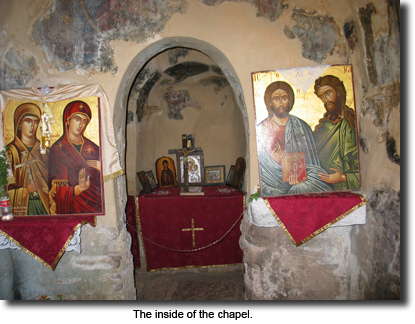
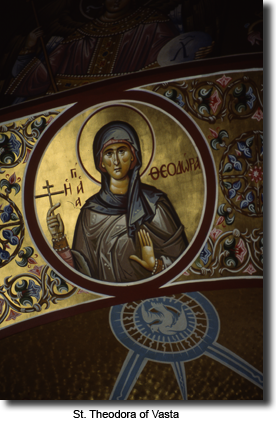
Mount Athos
The Skete of the Prophet Elias
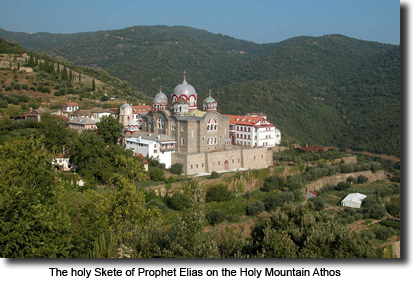
As a clergyman of the Russian Church Abroad, Father Gregory would visit the Holy Mountain on many occasions, taking time to visit the Skete of the Prophet Elias, since it was a populated by monastics of the Russian Church Abroad. His close connection to the Skete would prove profoundly beneficial for the Church in America in the years to come, since it was through Prophet Elias Skete that the largest portion in the United States of the true Cross of our Lord was given to Archbishop Gregory, among other holy objects.
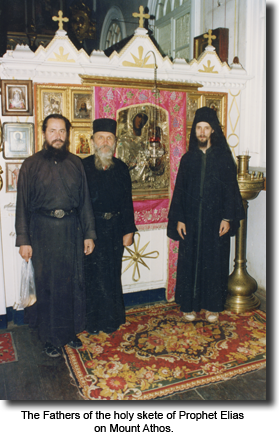
On the left is pictured Father John, who was the Skete’s hieromonk. To his left is the abbot, Archimandrite Seraphim. Both of them are wearing the monastic schema belt buckles that were designed and made at Dormition Skete. Not more than a year after this photograph was taken, Father John reposed in the Lord. He was a true confessor of the Faith and a great zealot of Orthodoxy. When the Skete of Prophet Elias needed monastics to populate it, so as not to let it fall into the hands of the Ecumenists, Father John volunteered to move to Mount Athos and live there. He had great love and devotion to Orthodoxy and lived a life dedicated to maintaining its purity.
On Mount Athos, a monk who dies is buried and his remains are exhumed after two or three years. They are washed and placed in the monastery’s charnel house, where the bones of all the monks of that monastery are laid to rest. The skulls are put in a separate room, and the name of that person is written on the skull. The monks of Prophet Elias would not uncover the remains of Father John until they knew that Father Gregory would be present, so they waited for his next visit. When this occurred, they uncovered his remains. The following pictures are showing Father Gregory washing the skull of Hieromonk John and painting his name on his skull. Notice the golden hue of Father John’s skull. May God grant him rest with the saints, for his skull resembles those of the relics of saints.
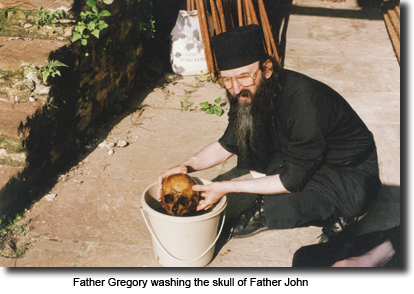
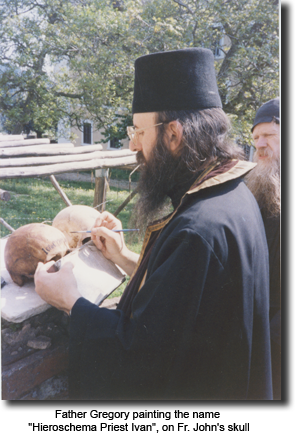
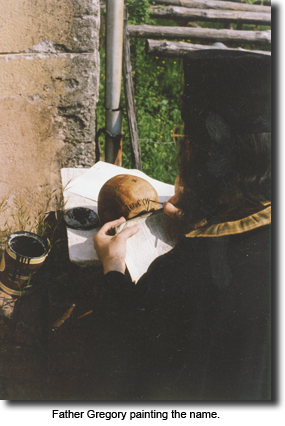
Monastery of Esphigmenou
Archbishop Gregory, then Father Gregory, with the future Bishop John, then Father George, visited the monastery of Esphigmenon shortly after the union of the Russian Church Abroad with the heretical Cyprianites. At the time, Esphigmenon was the only monastery of the ruling twenty great monasteries of Mount Athos that refused to commemorate the Ecumenical Patriarch because of his outrageous ecumenical agenda.
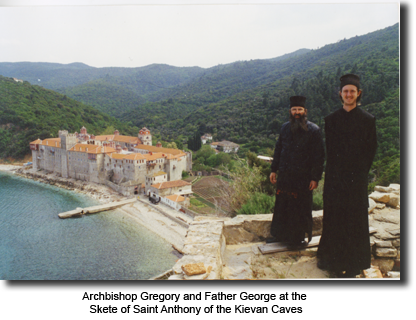
Father Gregory and Father George are shown outside the cave of Saint Anthony of the Kievan Caves, who first went to Mount Athos to receive monastic training. His cave is still there, high above the monastery.
When Ecumenism initially started in the Orthodox Church in the early part of the 20th century, the abbots of the major monasteries on Mount Athos refused to accept it. As a result, they were all systematically driven out of their monasteries and replaced with non-confessing abbots who had no hesitation in commemorating a heretic as their bishop in exchange for the glory and prestige that accompanies the monasteries of the Holy Mountain. All the abbots were removed except for the abbot of the Monastery of Esphigmenou, the late Archimandrite Efthymios, who successfully resisted the intrigues of the patriarchs Athenagoras and Demetrios. Archimandrite Efthymios had several edifying conversations with Archbishop Gregory during his visit there, whom he regarded as a true confessor of Orthodoxy. It was this abbot who recommended that Father Gregory join the Greek Old Calendarists who were in communion with the Russian Church Abroad when the Russian Church Abroad accepted the ecumenical heresy of Metropolitan Cyprian of Fili, Greece.
The Greek government, in collusion with Patriarch Demetrios of Constantinople, strove to break the resolve of the monks of Esphigmenon by blockading them with a Destroyer from the Greek Navy, which turned its guns towards the monastery, threatening it. The Monastery in turn unfurled a very big, black flag from the roof down the north wall, facing the Destroyer, which said, “Orthodoxy or Death!” When they saw that the monks would not acquiesce and would not convert to heresy, Demetrios ordered the Destroyer to depart, while he satisfied himself with the words, “At least we wrested nineteen of the twenty monasteries from the zealot monks of Athos.” Esphigmenou was then left in peace for a short space of time.
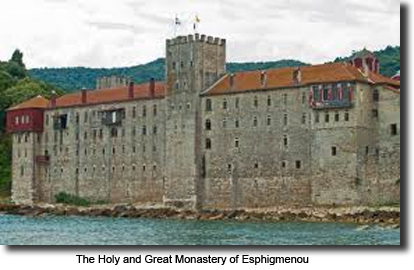
The Fathers unravelled a flag saying, “Orthodoxy or Death” from this wall.
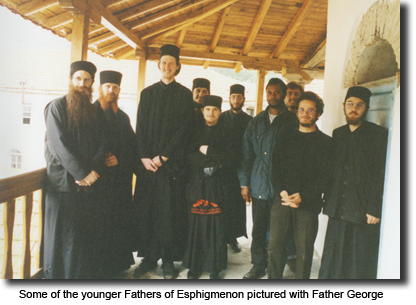
Monastery of Iveron
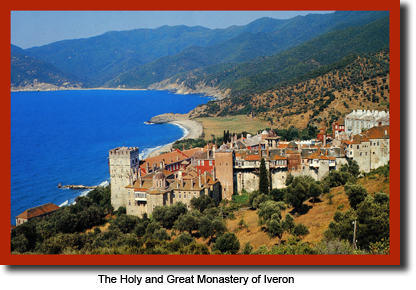
On another occasion Father Gregory had the opportunity to make a pilgrimage to the Holy Mountain with one of the rassophore monks of Dormition Skete. As on all his trips to the Holy Mountain, it was his first and foremost desire to visit the Monastery of Iveron and offer veneration to the miracle working icon of the Virgin Portaitissa, meaning Keeper of the Portal. This icon was saved from the iconoclasts in the 9th century in a miraculous manner. She appeared off the coast of the Holy Mountain again in a miraculous manner several hundred years later.
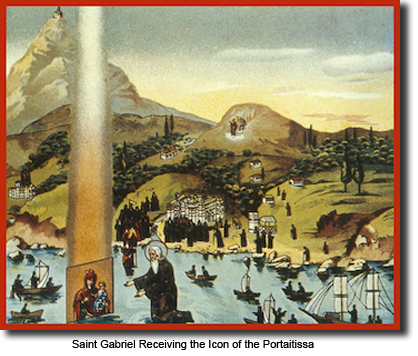
It is commonly known among the monks of the Holy Mountain that this icon will depart the Holy Mountain in a manner similar to how it came, that is, without human assistance. When this occurs, the monks will know that the time to depart the Holy Mountain has come.
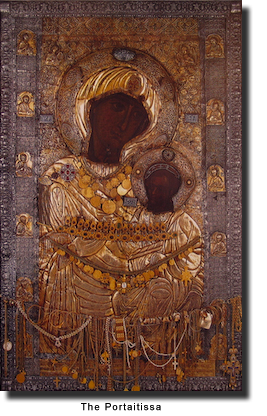
At the beginning of every trip to the Holy Mountain, Father Gregory would always come to visit the Portiatissa at Iveron Monastery. One of the last remaining monastics reputed to be gifted with divine foresight was living at Iveron at that time, namely, the Elder Maximos with his disciple, the monk Nektarios. Father Maximos was a zealot monk who refused to commemorate the heretical patriarch of Constantinople, Demetrios. Although he lived at Iveron, which was a commemorating monastery under the authority of Demetrios, yet because the monastery was idiorrhythmic at that time (the monks did not observe obedience under an abbot), Father Maximos was free to live according to his conscience in a quiet manner, without compromising his principles by praying with the “commemorator monks”. Father Maximos was given the honor of being the caretaker of the famous Portaitissa chapel.
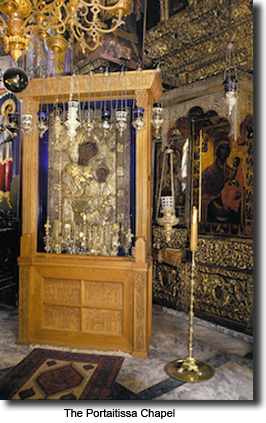
When Father Gregory entered the chapel of the Portaitissa, Father Maximos and his disciple were present there, sitting quietly, praying. The moment Father Gregory entered, he heard Father Maximos say to his disciple, “Get up, get up! A bishop is entering!” And so both immediately stood up and waited until Father Gregory had finished venerating the icon of the Virgin. Father Gregory felt awkward having these monastics remain standing while he was doing his prostrations.
Father Maximos then addressed Father Gregory, questioning him, “Where are you from, Despota?” Father Gregory answered, “America.” Father Maximos asked him, “Are you a bishop?” Father Gregory said, “No, I am a hieromonk.” He then introduced himself as Father Maximos, whereupon they greeted each other. Then Father Maximos asked him again, “Are you a bishop?” Father Gregory said, “No.”, to which Father Maximos expressed some measure of surprise.
After they prayed there for a while, Father Gregory and his companion departed Iveron on their pilgrimage throughout Athos. Father Gregory many times would smile, saying, “So much for the clairvoyance of this Father Maximos!” It was only years later, after he was consecrated a bishop, that Archbishop Gregory would scratch his head and realize that Father Maximos was indeed gifted with divine foreknowledge.
The Holy Monastery of Dionysiou
On another of Father Gregory’s visits to the Holy Mountain he visited the Monastery of Dionysiou. Dionysiou Monastery had the famous icon of the Akathist, which was reputed to have been painted by the Apostle Luke and came to the Holy Mountain from Constantinople. Also, the frescoes of this monastery are outstanding.
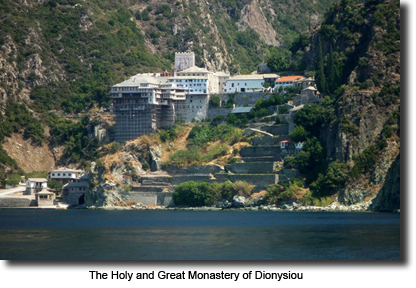
Father Gregory went there to speak with the abbot, Father Haralambos, whom he met many years prior to the present visit, when the former was living in New Skete in 1966. When Father Haralambos, unfortunately, became the abbot of this monastery, he had to commemorate the patriarch, who was ecumenical. To somehow show his disapproval of this situation, Father Haralambos would serve privately in the many small chapels of the monastery, and would not commemorate the patriarch at the typical time. It was Father Haralambos who gifted Father Gregory with the relics of the Elder Joseph for Dormition Skete in Colorado.
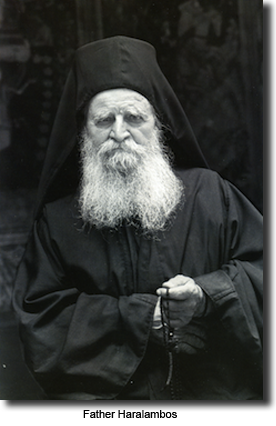
It just so happened while Fr. Gregory was staying at Dionysiou, the former abbot, Gabriel, reposed. Archimandrite Gabriel was famous throughout Mount Athos, and even in Greece, because of his various writings on the monastic life, and the spiritual life in general. At his funeral, all the abbots and representatives of various monasteries throughout Athos attended.
Below is a picture of Father Gabriel when he was ruling abbot of the monastery.
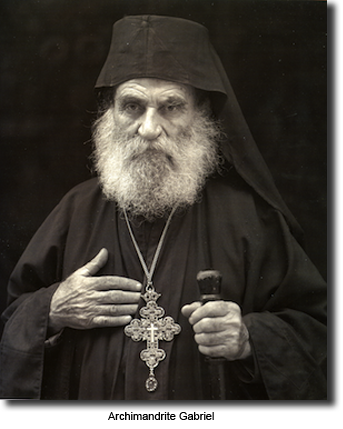
The Holy Monastery of Zographou
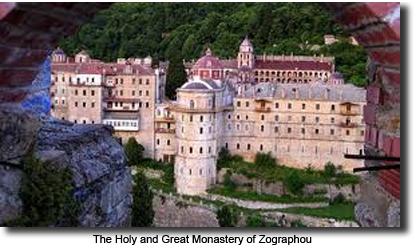
On one visit to the Holy Mountain, Bishop Gregory visited the Bulgarian Monastery of Zographou with two of Vladyka Gregory’s Bulgarian priests. The monastery is pictured above.
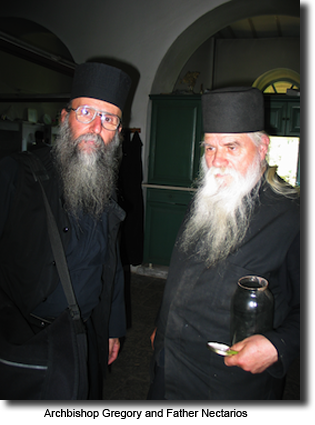
This Monastery, as are practically all the monasteries of Mount Athos, is ecumenical, in that they commemorate the patriarch of Constantinople who is an Ecumenist heretic. Of all the Bulgarians there, only one, Father Nectarios, refuses to acknowledge the Patriarch as his bishop. He is a Bulgarian who was allowed to live at the Monastery, even though he does not pray with the brotherhood or eat with them. He is a confessor of the Faith in these last times. He is pictured above with Bishop Gregory.
How could someone who lives in Zographou commemorate the Patriarch of Constantinople, who says that the Roman Catholics are Christians just like the Orthodox, when right inside the courtyard of the Monastery is the monument erected as a memorial to the twenty-six martyrs of Zographou who were burned to death at the hands of the Latin, Roman Catholic Papists? They were burned in the fifteen hundreds for refusing to commemorate the pope. Below is a picture of the monument which was erected on the place where the martyrs were murdered.
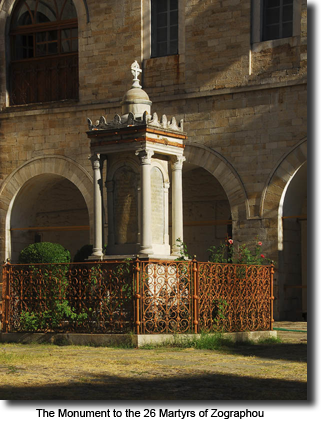
A Special Note
On many visits to Mount Athos, care had to be taken to enter without being noticed, since we are not in communion with the heretical patriarch of Constantinople. All clergymen entering the Holy Mountain have to be given special permission to enter from the Ecumenists who are in authority. Even though one tenth of all the monks on the Holy Mountain are non-commemorators, those in authority make it difficult for those who are true Orthodox to enter. Therefore, we who are the true children of the Orthodox Church have to enter at times by the back door.
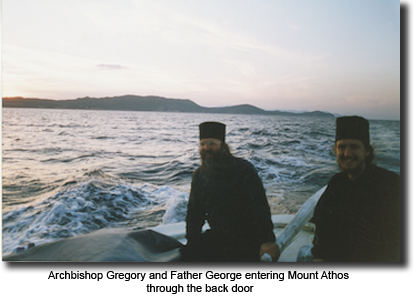
Hieroschemamonk Gabriel and Brotherhood
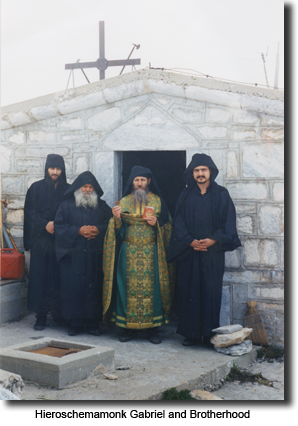
Hieromonk Gabriel, our fellow zealot monastic on the Holy Mountain who is of one mind and one heart with us, is depicted here after finishing the Liturgy in the chapel of the Transfiguration on the top of Mount Athos. It is from this chapel that the blessing of grapes is performed by a hieromonk every year on the feast of the Transfiguration.
On the Holy Mountain and to the Peak
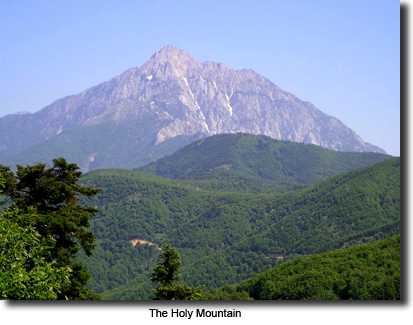
On another occasion, Father Gregory visited Mount Athos, where he fulfilled a life-long dream. He wanted to ascend Mount Athos to the peak and venerate the two churches; one at the top, which is dedicated to the Transfiguration, and one below it, which is dedicated to the Mother of God. On this visit to Mount Athos he accomplished this feat. It takes three days from sea level to ascend the Mountain. The monks were very kind to Father Gregory, and they gave him a donkey to travel part of the way. Father Gregory went with two of his disciples, Father George and the novice Nicholas. When they arrived at the top of Mount Athos, this was the sight:
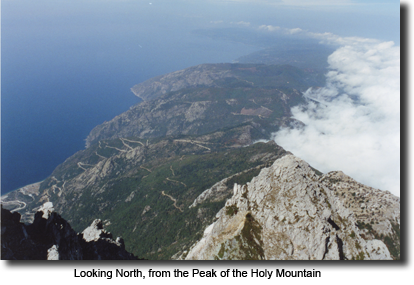
One could see that Mount Athos was covered with “ribbons”, as the prophecy of St. Nilos described. From on top of Mount Athos the roads that criss-crossed the Mountain and the peninsula appeared as ribbons. The saint said, “When you see the Holy Mountain covered in ribbons and cords, know that the end is near.” No one could understand what this prophecy meant at the time, for how could the Holy Mountain be covered with ribbons and cords? The roads appeared as ribbons, and the telephone lines which can be seen as the pilgrims ascended the Mountain and the peninsula were indeed the cords. Today even the small kellias in the desert parts of Mount Athos have telephone service. Saint Nilos of Mount Athos gave this prophecy in the 18th century.
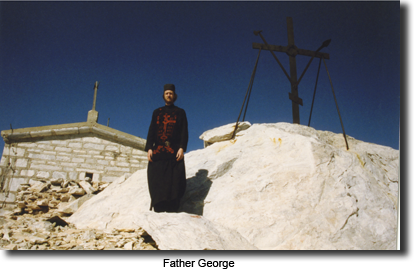
The above picture is Bishop John when he was Father George, shown right below the peak of Athos.
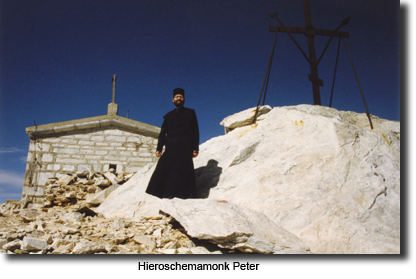
Above is the picture of Father Peter, then novice Nicholas. He was given his black in the chapel of the Transfiguration on the peak of Mount Athos, and by coincidence, three years later, he was tonsured on the Feast of the Transfiguration.
One can notice all the rocks are small because of lighting strikes. The cross that is in the rock is made out of steel and acts as a lightning rod, and on the roof of the chapel, one can see a lightning rod also.
It took three days to descend the Holy Mountain. During this time, Father Gregory, Father George and the novice Nicholas visited a zealot Skete at their feast day celebration. The zealots of the Holy Mountain are those who do not accept the Patriarch of Constantinople because of his heretical Ecumenism. They were thrown out of the major monasteries because they would not commemorate a heretic in the Liturgy. They are of one mind and one heart with us, the true Orthodox in America. They gathered outside their church, so that we could take a photograph of them, which is shown below.
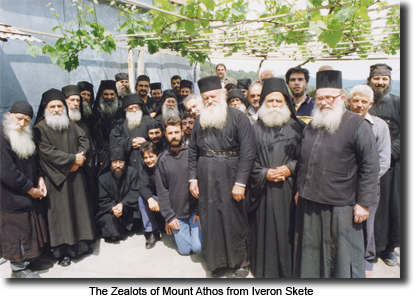
Iveron Skete is inhabited by zealot monks who do not commemorate the heretical patriarch as well. The whole brotherhood is pictured here, with their humble abbot, the fifth from the left, Father Vasilios. In this Skete are the incorrupt relics of the holy new martyrs Efthymios, Ignatios and Akakios, who were martyred by the Turks.
Russia
On November 17, 2001, Archbishop Gregory was ordained a bishop in Suzdal, Russia. During this trip he and Bishop John visited Red Square in Moscow.
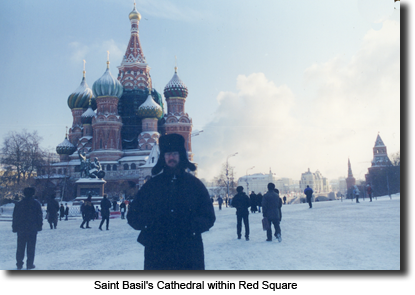
It just so happens that within Red Square the tomb of Lenin still remains, the atheist and the instigator of the Bolshevik Revolution. The Soviets mummified his body and built a mausoleum to house it.
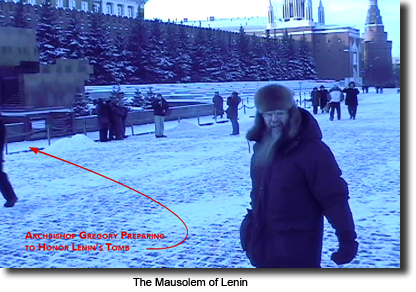
Above is a photograph of Archbishop Gregory preparing to “honor” this wretched man’s tomb. Lenin was responsible for the murder of approximately twenty million Orthodox Christians.
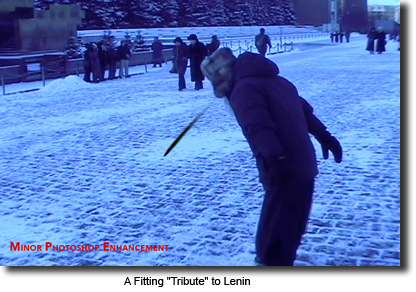
Above is a photograph of Archbishop Gregory paying due honor to Lenin’s tomb, with a slight modification to illustrate the point.
Eternal memory to all the innocent souls who were murdered by Lenin because of their Orthodox Faith.
Bulgaria
Rila Monastery in Bulgaria
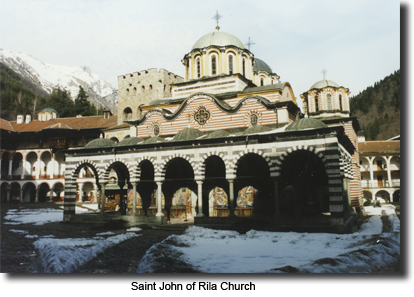
On another occasion when Father Gregory became Bishop Gregory, he ordained priests in Bulgaria. On one of his pastoral visits, he was taken to the great Monastery of Saint John of Rila. Here are some of the pictures which he took of the monastery, which at the present time does function as a monastery, but unfortunately is with the Ecumenists.
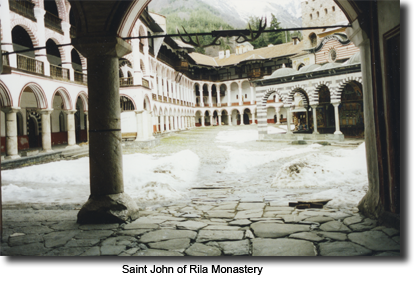
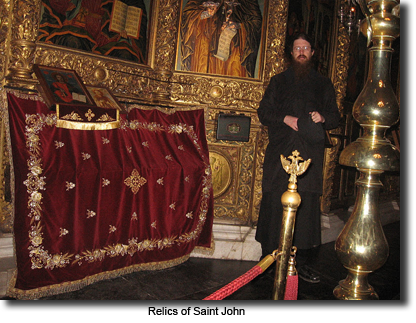
Above is pictured Bishop John next to the relics of Saint John of Rila. Unfortunately they are covered. The custodian, who is a hieromonk, recognized us, and knowing that we are non-ecumenists, showed no desire to uncover the relics.
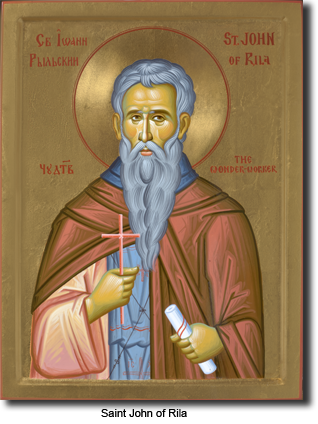
The Monastery of Saint Clement of Ochrid
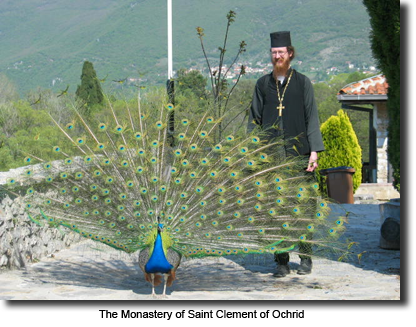
On our trip to Bulgaria, we had an occasion to go to Skopye (Macedonia) and visit the Monastery of St. Clement of Ochrid. Saint Clement stipulated during his lifetime that his monastery should always have peacocks. He loved peacocks because they symbolize the grace of the Holy Spirit, with His many and varied gifts. Above is one of the peacocks with Vladyka John.
The Pope’s Visit to Bulgaria
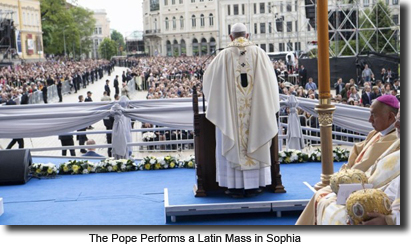
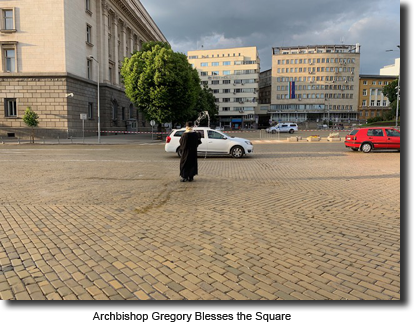
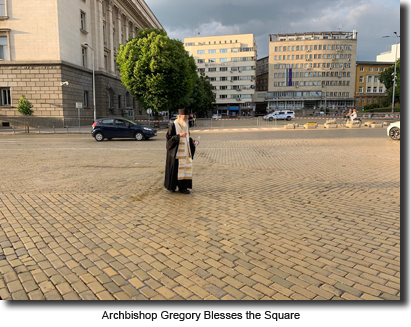
On May 5th, 2019, the Pope visited Bulgaria. Our faithful there were not happy that he had come and celebrated a Latin mass in the middle of the square in Sophia, the capital. They asked Vladika Gregory to come and bless the square to rid it of the pollution and curse caused by the Pope. Two weeks later, Vladika Gregory arrived in Bulgaria and blessed the square with holy water to the great gratitude of our faithful.
|
Archbishop Gregory Dormition Skete P.O. Box 3177 Buena Vista, CO 81211-3177 USA |

|
|
|
Copyright 2011 - Archbishop Gregory Last Updated: July 12, 2011 |
